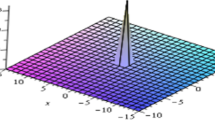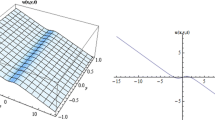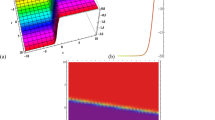Abstract
The new Kudryashov approach, with the help of symbolic calculations, has been used to obtain solitary wave solutions of the Calogero–Degasperis (CD) and potential Kadomtsev–Petviashvili (pKP) equations in this paper. These equations arise in a number of scientific models, including astrophysics, plasma physics, fluid mechanics, chemical chemistry, solid-state physics, chemical kinematics, optical fiber, and geochemistry. A number of new solitary wave (SW) solutions to these two equations are observed for the first time. We believe that this approach is one of the most efficient schemes for obtaining new SW solutions of nonlinear evolution equations (NLEEs). NLEEs arising in nonlinear sciences play an important role in understanding the nonlinear phenomenon. Solitons consist of huge applications in physics, communication systems, optical science, applied mathematics, and engineering problems. They are generally used to emphasize the motion of separated waves. In recent years, it has been a very interesting topic to discuss the SW solutions of NLEEs.
Similar content being viewed by others
Avoid common mistakes on your manuscript.
1 Introduction
Many phenomena in nature are often demonstrated by nonlinear evolution equations (NEEs), such as plasma physics, electromagnetic theory, solid-state physics, chemical kinetics, fluid dynamics, and mathematical biology. Suppose we want to understand better the physical mechanism of the natural phenomenon described by NEEs. In that case, we must look for solitary wave (SW) solutions to the NEEs, so techniques for extracting SW solutions to the governing equations must be developed. Examining SW solutions to solve NEEs has become one of the most important concerns of scientists in various sciences. In recent decades, there have been many powerful techniques for obtaining SW solutions for NEEs. For example, the new extended direct algebraic technique (Vahidi et al. 2021), the generalized exponential rational function technique (Ismael et al. 2021), the Adomian decomposition technique (Sunthrayuth et al. 2021), the singular manifold technique (Saleh et al. 2021), the generalized (G'/G)-expansion technique (Li and Han 2020), the sine–cosine technique (Abdelrahman et al. 2020), the simplified Hirota’s technique (Ismael et al. 2021), the homogeneous balance technique (Fan 2000), the variational iteration approach (He 1999), the modified Sardar Sub-equation technique (Saliou et al. 2021), the Jacobi elliptic function technique (Kudryashov 1919), the simplest equation technique (Kudryashov 2005) and exp-function technique (Navickas et al. 2010), etc. (Kumar et al. 2017; Kumar et al. 2021; Khatri et al. 2019, 2020; Fatema et al. 2022; Ekramul and Ali Akbar 2021; Chu et al. 2021; Yiasir Arafat et al. 2023; Fatema et al. 2022; Arafat et al. 2022; Odabaşı 2021; Jafari et al. 2012).
In this work, by means of the new Kudryashov approach, we will get some SW solutions of the following CD and the pKP equations given in Yusufoglu and Bekir (2007) and Kumar et al. (2021):
and
respectively. Equation (1) was to describe the (2 + 1)-dimensional interaction of a Riemann wave propagating along the y-axis with a long wave along the x-axis, first developed by Degasperis and Calogero (1976). Equation (2) can be used to describe the dynamics of small, small but limited two-dimensional waves in various fields of research, which is the generalized (2 + 1)-dimensional equation of Korteweg-de Vries (KdV) (Gao and Zhang 2020). In addition, these equations arises in number of scientific models including astrophysics, fluid mechanics, chemical kinematics, solid-state physics, plasma physics, chemical chemistry and optical fiber (Jumarie 2006; Jafari and Tajadodi 2010; Biswas and Ranasinghe 2010; Ghorbani and Saberi-Nadjafi 2007).
2 The new Kudryashov approach
The purpose of this section is to explain the use of the new Kudryashov approach (Mirhosseini-Alizamini et al. 2021) to solve nonlinear evolution equations. Suppose a nonlinear EE for \(v(x,y,t)\), in the form
The transformation
reduces (3) to the ODE
where \(\lambda\) is constant. Assume that in terms of \(\aleph (\varsigma )\) the solution to ODE (5) is as follows:
where \(\aleph (\varsigma )\) satisfies the first-order ODE in the form
where \(\beta_{\iota } (0 \le \iota \le \kappa ),a,b\) and \(\sigma\) are constants. The solutions of Eq. (7) is
Substitute Eq. (6) into Eq. (5). Consequently, we get a polynomial of this substitution. In this polynomial, we gather all terms of the same powers and equate them to zero.
This leads to a system of algebraic equations that can be solved by Maple software and gives us unknown parameters \(\beta_{0} ,\beta_{1} , \ldots ,\beta_{\kappa }\)\(\lambda\); as a result, we get the SW solutions of Eqs. (1) and (2).
3 The CD equation
To find the SW solutions of Eq. (1), transformations (4) are written as ODE as follows:
Integrating (9) once, we obtain
If we catch the transformation \(\wp = V^{\prime}\), then (11) can be written as follows:
Balancing the terms \(\wp^{2}\) and \(\wp^{\prime\prime}\), we get \(2\kappa = \kappa + 2 \Rightarrow \kappa = 2.\) By substituting \(\kappa = 2\) into (6), we get
A set of algebraic equations for \({\mkern 1mu} \beta_{0} ,\beta_{1} ,\beta_{2}\) and \({\mkern 1mu} a,b,\sigma ,\lambda\) is obtained by replacing (12) in Eq. (11). These systems are found as
In solving the above algebraic system using Maple, the following sets are obtained.
Set I.
Set II.
From Eqs. (12) and (14), we get the following SW solutions:
Integrating Eq. (16) once, we will obtain
or
From Eqs. (12) and (15), we get the following SW solutions:
Integrating Eq. (19) once, we will obtain
or
Kink-shaped soliton of Eq. (1) for \(\sigma = 2,a = 0.2,b = 0.5,y = 0.5,\Xi = 2.6,\) within the interval \(- 5 \le x\,,\,t \le 5\), the top left figure shows the 3D plot, the top right figure shows contour plot, the bottom left figure shows the 2D plot and the bottom right figure shows polar coordinates for \(t = 0,0.3,0.6\) (Fig. 1).
I 3D plot, II Contour plot, III 2D plot and IV polar coordinates of Eq. (18) when \(\sigma = 2, a = 0.2, b = 0.5,\) and \(y = 0.5,\) with \(\Xi = 2.6\)
4 The pKP equation
To find the SW solutions of Eq. (2), transformations (4) are written as ODE as follows:
Integrating (22) once, we obtain
If we catch the transformation \(\wp = V^{\prime}\), then (23) can be written as follows:
Balancing the terms \(\wp^{2}\) and \(\wp^{\prime\prime}\), we get \(2\kappa = \kappa + 2 \Rightarrow \kappa = 2.\) By substituting \(\kappa = 2\) into (6), we get
A set of algebraic equations for \({\mkern 1mu} \beta_{0} ,\beta_{1} ,\beta_{2}\) and \({\mkern 1mu} a,b,\sigma ,\lambda\) is obtained by replacing (25) in Eq. (24). These systems are found as
In solving the above algebraic system using Maple, the following sets are obtained.
Set I.
Set II.
From Eqs. (25) and (27), we get the following SW solutions:
Integrating Eq. (29) once, we will obtain
or
From Eqs. (25) and (28), we get the following SW solutions:
Integrating Eq. (32) once, we will obtain
or
Singular Kink soliton of Eq. (2) for \(\sigma = 2,a = 0.5,b = 0.75,y = 1,\Xi = e,\) within the interval \(- 5 \le x\,,\,t \le 5\), the top left figure shows the 3D plot, the top right figure shows contour plot, the bottom left figure shows the 2D plot and the bottom right figure shows polar coordinates for \(t = 0,0.3,0.6\) (Fig. 2).
I 3D plot, II contour plot, III 2D plot and IV polar coordinates of Eq. (34) when \(\sigma = 2,a = 0.5,b = 0.75,\) and \(y = 1,\) with \(\Xi = e\)
5 Conclusions
In this paper, we obtain the new SW solutions of the CD and pKP equations using the new Kudryashov approach and with the help of symbolic calculations. It is worthwhile to mention that this approach is effective and reliable in solving NLEEs. The applied approach will be used in further works to establish more entirely new SW solutions for other kinds of NLEEs.
Data availability
The authors do not have permissions to share data.
References
Abdelrahman MAE et al (2020) New solutions for the unstable nonlinear Schrödinger equation arising in natural science. Aims Math 5(3):1821–1120
Arafat SMY et al (2022) Promulgation on various genres soliton of Maccari system in nonlinear optics. Opt Quantum Electron 54(4):206
Biswas A, Ranasinghe A (2010) Topological 1-soliton solution of Kadomtsev-Petviashvili equation with power law nonlinearity. Appl Math Comput 217(4):1771–1773
Calogero F, Degasperis A (1976) Nonlinear evolution equations solvable by the inverse spectral transform.—I. Il Nuovo Cimento B (1971-1996) 34:201–242
Chu Y-M et al (2021) Extension of the sine-Gordon expansion scheme and parametric effect analysis for higher-dimensional nonlinear evolution equations. J King Saud Univ-Sci 33(6):101515
Fan E (2000) Two new applications of the homogeneous balance method. Phys Lett A 265(5–6):353–357
Fatema K et al (2022) Solitons’ behavior of waves by the effect of linearity and velocity of the results of a model in magnetized plasma field. J Ocean Eng Sci. https://doi.org/10.1016/j.joes.2022.07.003
Fatema K et al (2022) Transcendental surface wave to the symmetric regularized long-wave equation. Phys Lett A 439:128123
Gao M, Zhang H-Q (2020) Solitary wave solutions, lump solutions and interactional solutions to the (3+ 1)-dimensional generalized B-type Kadomtsev-Petviashvili equation. Int J Mod Phys B 34(07):2050053
Ghorbani A, Saberi-Nadjafi J (2007) He’s homotopy perturbation method for calculating adomian polynomials. Int J Nonlinear Sci Numer Simul 8(2):229–232
He J-H (1999) Variational iteration method–a kind of nonlinear analytical technique: some examples. Int J Nonlinear Mech 325:699–708
Islam ME, Ali Akbar M (2021) Study of the parametric effects on soliton propagation in optical fibers through two analytical methods. Opt Quantum Electron 53:1–20
Ismael HF, Bulut H, Baskonus HM (2021) W-shaped surfaces to the nematic liquid crystals with three nonlinearity laws. Soft Comput 25(6):4513–4524
Ismael HF, Murad MAS, Bulut H (2021) Various exact wave solutions for KdV equation with time-variable coefficients. J Ocean Eng Sci 7:409–418
Jafari H, Tajadodi H (2010) He’s variational iteration method for solving fractional Riccati differential equation. Int J Differ Equ. https://doi.org/10.1155/2010/764738
Jafari H, Kadkhoda N, Khalique CM (2012) Travelling wave solutions of nonlinear evolution equations using the simplest equation method. Comput Math Appl 627:2084–2088
Jumarie G (2006) Modified Riemann-Liouville derivative and fractional Taylor series of nondifferentiable functions further results. Comput Math Appl 51(9–10):1367–1376
Khatri H, Gautam MS, Malik A (2019) Localized and complex soliton solutions to the integrable (4+ 1)-dimensional Fokas equation. SN Appl Sci 1:1–9
Khatri H, Malik A, Gautam MS (2020) Traveling, periodic and localized solitary waves solutions of the (4+ 1)-dimensional nonlinear Fokas equation. SN Appl Sci 2:1–16
Kudryashov NA (1919) On types of nonlinear nonintegrable equations with exact solutions. Phys Lett A 155(4–5):269–275
Kudryashov NA (2005) Simplest equation method to look for exact solutions of nonlinear differential equations. Chaos Solitons Fractals 226:1217–1231
Kumar H et al (2017) Dynamics of shallow water waves with various Boussinesq equations. Acta Phys Pol A 131(2):275–282
Kumar D et al (2021) Wave propagation of resonance multi-stripes, complexitons, and lump and its variety interaction solutions to the (2+ 1)-dimensional pKP equation. Commun Nonlinear Sci Numer Simul 100:105853
Kumar H, Kumar A, Chand F, Singh RM, Gautam MS (2021) Construction of new traveling and solitary wave solutions of a nonlinear PDE characterizing the nonlinear low-pass electrical transmission lines. Phys Scripta 96(8):085215
Li Z, Han T (2020) Bifurcation and exact solutions for the (2+ 1)-dimensional conformable time-fractional Zoomeron equation. Adv Differ Equ 2020(1):1–13
Mirhosseini-Alizamini SM, Ullah N, Sabi’u J, Rezazadeh H, Inc M (2021) New exact solutions for nonlinear Atangana conformable Boussinesq-like equations by new Kudryashov method. Int J Mod Phys B 35(12):2150163
Navickas Z, Ragulskis M, Bikulciene L (2010) Be careful with the Exp-function method–additional remarks. Commun Nonlinear Sci Numer Simul 15(12):3874–3886
Odabaşı M (2021) Exact analytical solutions of the fractional biological population model, fractional EW and modified EW equations. Int J Optim Control Theories Appl (IJOCTA) 11:52–58
Saleh R, Mabrouk SM, Wazwaz AM (2021) The singular manifold method for a class of fractional-order diffusion equations. Waves Random Complex Media. https://doi.org/10.1080/17455030.2021.2017069
Saliou Y et al (2021) W-shape bright and several other solutions to the (3+ 1)-dimensional nonlinear evolution equations. Mod Phys Lett B 35(30):2150468
Sunthrayuth P et al (2021) The numerical investigation of fractional-order Zakharov-Kuznetsov equations. Complexity. https://doi.org/10.1155/2021/4570605
Vahidi J et al (2021) New extended direct algebraic method for the resonant nonlinear Schrödinger equation with Kerr law nonlinearity. Optik 227:165216
Yiasir Arafat SM et al (2023) The mathematical and wave profile analysis of the Maccari system in nonlinear physical phenomena. Opt Quantum Electron 55(2):136
Yusufoglu E, Bekir A (2007) New exact and explicit traveling wave solutions for the CD and PKP equations. Int J Nonlinear Sci 9:8–14
Author information
Authors and Affiliations
Contributions
Rui Cui: writing—original draft preparation, conceptualization, supervision, project administration.
Corresponding author
Ethics declarations
Conflict of interest
The authors declare no competing of interests.
Additional information
Publisher's Note
Springer Nature remains neutral with regard to jurisdictional claims in published maps and institutional affiliations.
Rights and permissions
Springer Nature or its licensor (e.g. a society or other partner) holds exclusive rights to this article under a publishing agreement with the author(s) or other rightsholder(s); author self-archiving of the accepted manuscript version of this article is solely governed by the terms of such publishing agreement and applicable law.
About this article
Cite this article
Cui, R. New waveform solutions of Calogero–Degasperis (CD) and potential Kadomtsev–Petviashvili (pKP) equations. Multiscale and Multidiscip. Model. Exp. and Des. 7, 1673–1678 (2024). https://doi.org/10.1007/s41939-023-00254-w
Received:
Accepted:
Published:
Issue Date:
DOI: https://doi.org/10.1007/s41939-023-00254-w






